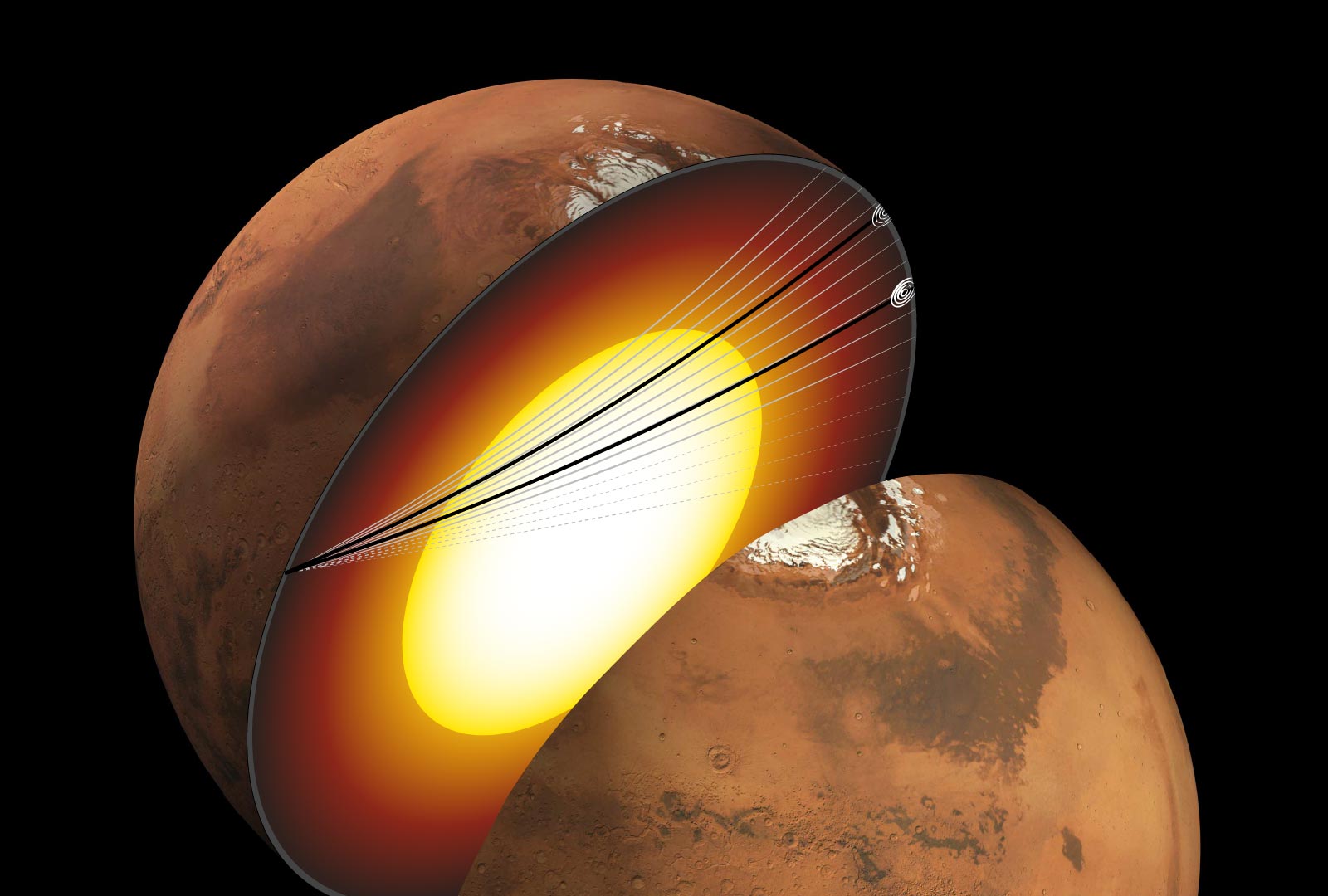

Das Konzept dieses Künstlers zeigt einen Ausschnitt des Mars zusammen mit den Spuren seismischer Wellen von zwei verschiedenen Erdbeben im Jahr 2021. Diese seismischen Wellen, die von der InSight-Mission der NASA entdeckt wurden, sind die ersten jemals identifizierten seismischen Wellen, die in den Kern eines anderen Planeten eindringen. Bildnachweis: NASA/JPL-Caltech/University of Maryland
neu[{“ attribute=““>NASA InSight research reveals that Mars has a liquid core rich in sulfur and oxygen, leading to new clues about how terrestrial planets form, evolve and potentially sustain life.
NASA’s InSight lander has discovered that Mars has a completely liquid core, rich in sulfur and oxygen. This finding offers new insights into Mars’ formation, its differences from Earth, and the implications for planetary habitability. Mars’ core is less dense and lacks a protective magnetic field, suggesting that it may have evolved from a potentially habitable environment to its current hostile state.
Scientists observed seismic waves traveling through Mars’ core for the first time and confirmed model predictions of the core’s composition.
An international research team—which included University of Maryland seismologists—used seismic data acquired by the NASA InSight lander to directly measure properties of Mars’ core, finding a completely liquid iron-alloy core with high percentages of sulfur and oxygen. Published on April 24, 2023, in the Proceedings of the National Academy of Sciences, these findings reveal new insights into how Mars formed and geological differences between Earth and Mars that may ultimately play a role in sustaining planetary habitability.
“In 1906, scientists first discovered the Earth’s core by observing how seismic waves from earthquakes were affected by traveling through it,” said UMD Associate Professor of Geology Vedran Lekic, second author of the paper. “More than a hundred years later, we’re applying our knowledge of seismic waves to Mars. With InSight, we’re finally discovering what’s at the center of Mars and what makes Mars so similar yet distinct from Earth.”
To determine these differences, the team tracked the progression of two distant seismic events on Mars, one caused by a marsquake and the other by a large impact, and detected waves that traveled through the planet’s core. By comparing the time it took those waves to travel through Mars compared to waves that stayed in the mantle, and combining this information with other seismic and geophysical measurements, the team estimated the density and compressibility of the material the waves traveled through. The researchers’ results indicated that Mars most likely has a completely liquid core, unlike Earth’s combination of a liquid outer core and solid inner core.

An artist’s depiction of the Martian interior and the paths taken by the seismic waves as they traveled through the planet’s core. Credit: Image courtesy of NASA/JPL and Nicholas Schmerr
Additionally, the team inferred details about the core’s chemical composition, such as the surprisingly large amount of light elements (elements with low atomic numbers)—namely sulfur and oxygen—present in Mars’ innermost layer. The team’s findings suggested that a fifth of the core’s weight is made up of those elements. This high percentage differs sharply from the comparatively lesser weight proportion of light elements in Earth’s core, indicating that Mars’ core is far less dense and more compressible than Earth’s core, a difference that points to different conditions of formation for the two planets.
“You can think of it this way; the properties of a planet’s core can serve as a summary about how the planet formed and how it evolved dynamically over time. The end result of the formation and evolution processes can be either the generation or absence of life-sustaining conditions,” explained UMD Associate Professor of Geology Nicholas Schmerr, another co-author of the paper. “The uniqueness of Earth’s core allows it to generate a magnetic field that protects us from solar winds, allowing us to keep water. Mars’ core does not generate this protective shield, and so the planet’s surface conditions are hostile to life.”
Although Mars does not currently have a magnetic field, scientists hypothesize that there was once a magnetic shielding similar to Earth’s core-generated field due to traces of magnetism lingering in Mars’ crust. Lekic and Schmerr noted that this might mean that Mars gradually evolved to its current conditions, changing from a planet with a potentially habitable environment into an incredibly hostile one. Conditions in the interior play a key role in this evolution, as might violent impacts, according to the researchers.
“It’s like a puzzle in some ways,” Lekic said. “For example, there are small traces of hydrogen in Mars’ core. That means that there had to be certain conditions that allowed the hydrogen to be there, and we have to understand those conditions in order to understand how Mars evolved into the planet it is today.”
The team’s findings have ultimately confirmed the accuracy of current modeling estimates that aim to unravel the layers hidden beneath a planet’s surface. For geophysicists like Lekic and Schmerr, research like this is also paving the way for future geophysics-oriented expeditions to other celestial bodies, including planets like Venus and Mercury.
“This was a huge effort, involving state-of-the-art seismological techniques which have been honed on Earth, in conjunction with new results from mineral physicists and the insights from team members who simulate how planetary interiors change over time,” noted Jessica Irving, a senior lecturer at Bristol University and first author of the study. “But the work paid off, and we now know much more about what’s happening inside the Martian core.”
“Even though the InSight mission ended in December 2022 after four years of seismic monitoring, we’re still analyzing the data that was collected,” Lekic said. “InSight will continue to influence how we understand the formation and evolution of Mars and other planets for years to come.”
For more on this research, see Seismic Waves Reveal the Red Planet’s Inner Secrets.
Reference: “First observations of core-transiting seismic phases on Mars” by Jessica C. E. Irving, Vedran Lekic, Cecilia Durán, Mélanie Drilleau, Doyeon Kim, Attilio Rivoldini, Amir Khan, Henri Samuel, Daniele Antonangeli, William Bruce Banerdt, Caroline Beghein, Ebru Bozdag, Savas Ceylan, Constantinos Charalambous, John Clinton, Paul Davis, Raphaël Garcia, Domenico Giardini, Anna Catherine Horleston, Quancheng Huang, Kenneth J. Hurst, Taichi Kawamura, Scott D. King, Martin Knapmeyer, Jiaqi Li, Philippe Lognonné, Ross Maguire, Mark P. Panning, Ana-Catalina Plesa, Martin Schimmel, Nicholas C. Schmerr, Simon C. Stähler, Eleonore Stutzmann and Zongbo Xu, 24 April 2023, Proceedings of the National Academy of Sciences.
DOI: 10.1073/pnas.2217090120
This research was supported by NASA (Grant Nos. 80NSSC18K1628 and 80NSSC19M0216) and the SSERVI Cooperative Agreement. This story does not necessarily reflect the views of these organizations.

„Zertifizierter Unruhestifter. Freundlicher Forscher. Web-Freak. Allgemeiner Bierexperte. Freiberuflicher Student.“





More Stories
Die Federal Aviation Administration fordert eine Untersuchung des Misserfolgs bei der Landung der Falcon-9-Rakete von SpaceX
Identische Dinosaurier-Fußabdrücke auf zwei Kontinenten entdeckt
SpaceX startet 21 Starlink-Satelliten mit einer Falcon 9-Rakete von Cape Canaveral aus – SpaceflightNow